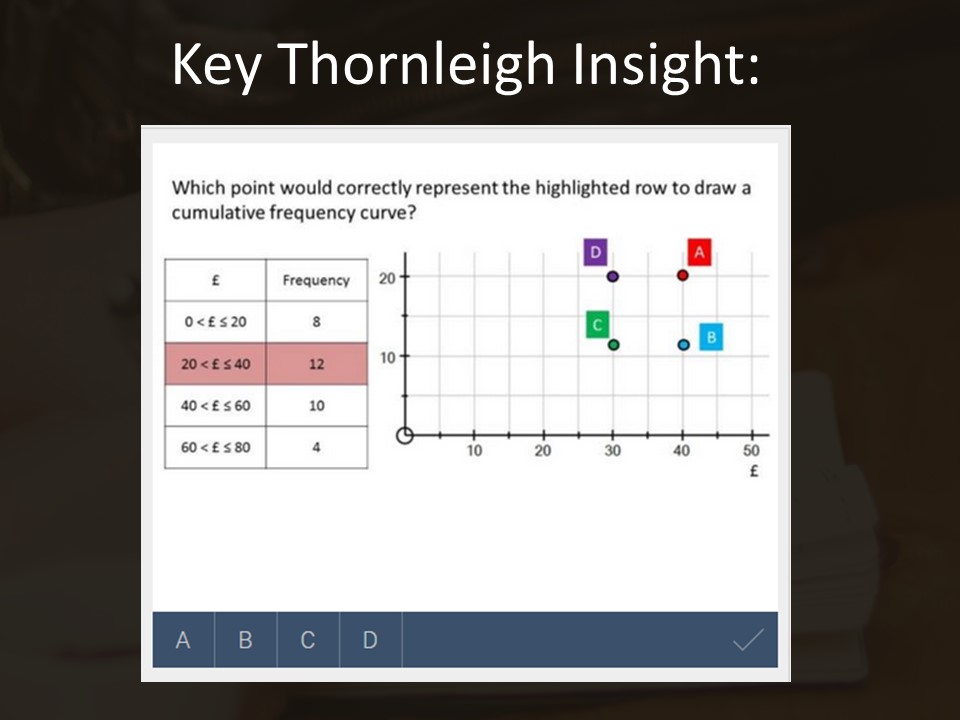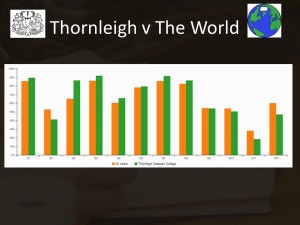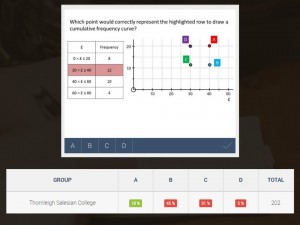“What misconceptions do GCSE Maths students have when it comes to plotting cumulative frequency diagrams from grouped data?”
The number of students around the country taking these weekly quizzes is growing and growing, and as it does, their teachers are learning more and more about the key holes in their knowledge. If you haven’t got invovled yet, now is the perfect time. It is completely free, and always will be.
Each week we set all our Year 11 Higher GCSE students a GCSE Essential Skills Quiz from my Diagnostic Questions website. These quizzes are completely free and are designed to test the content that appears on the majority of GCSE higher maths papers. These are the kind of questions that students should get right, but which time and time again cost our Year 11s the valuable marks that prevent them getting the grade they want.
We set our quizzes on a Monday, the students complete them for Friday, and then I sit down with a Mellow Birds coffee and a yoghurt (it is the weekend, after all) to analyse the results. I try to find one key insight, and then share it with staff in our weekly Departmental Meeting in a 5 minute slot called “Insight of the Week”.
Quiz 4 is below, followed by the key insight from this week.
How our students performed compared to the rest of the world:
We had issues with percentage multipliers and probability tree diagrams, but by far our biggest issue was with plotting cumulative frequency diagrams:
A measly 18% of our Year 11s got this question correct, with Options B and C tempting many of them.
Plotting cumulative frequency diagrams is one of those topics people can take for granted. Students have drawn 100s of them so assume they are dead easy. Likewise, I know I have been guilty of assuming that our students will be absolutely fine, and instead focussing on more tricky topics. However, there is no hiding from the fact that every time our students encounter a cumulative frequency diagram on an exam, the same classic mistakes with plotting the points occur again and again. That was clearly evident in this question.
Incorrect Answer B (45% of our students chose this)
This was the most popular choice amongst our lot. As you can see from the explanation, they have correctly identified that cumulative frequency needs to be plotted against the upper boundary of the interval. However, they have fallen into the trap of plotting frquency, and not cumulative frequency
“In cumulative frequency you use the highest point which is 40 and the frequency is also plotted which is 12.”
“You have to use the upper bound and the 12”
Incorrect Answer B (31% of our students chose this)
Coming in at Number 2 on the popular choices list is an answer that reveals two misconceptions. These students have also plotted frequency instead of cumulative frequency, but have also plotted against the midpoint of the interval instead of the upper bound:
“30 is the midpoint in between 20 and 40 and c is at 30 and 12”
“The middle is £30 and it shows the pound sign on the x axis, then frequency is on the y axis and then you just plot where it’s telling you to plot”
Incorrect Answer C (5% of our students chose this)
Not many of our students were tempted by this, but those who did revealed that they remembered how to calculate cumulative frequency, but were still tempted by that all too inviting midpoint:
“it shows the correct point on the graph between £20 and £40 as you add 8 and 20 to get the cumulative frequency”
“Find in between 20 and 40 for 30, then find the cumulative frequency for the coordinates of (30,20)”
The Correct Answer!
One of my motivations for developing Diagnostic Questions was so that students all around the world could learn from each other. When your students finish a quiz, please encourage them to review their answers, reading through other students’ explanations, until they find the magic one that makes sense to them. So, what are our Year 11 students’ favourite correct explanations to help them resolve their own misconceptions?
“Cumulative frequency is adding the frequencies one by one and must always be plotted on the upper bound”
“you plot it at the upper bound (40) and the cumulative frequency is 20 because 8+12 = 20”
“because you would plot at the upper bound and as cumulative frequency means running total you would do 8 + 12=20”
“Upper bound and the running total”
Tackling the Misconception in Class
So, when we discussed this insight in our Departmental Meeting, what ideas did we come up with for resolving the misconceptions in lessons this coming week with our students:
- Emphasise where the word cumulative comes from (to accumulate) and ensure students know it means a ‘running total’
- I feel it is important then when teaching any stats lesson involving a table of values, whether it be grouped frequency on non-grouped frequency, students should be challenged to say what each number means. So, if you have a cumulative frequency column, put a circle around one of the numbers, and ask the students to write down what it means in terms of the question. This gets students away from automatically processing numbers without thinking, and hopefully will make them make less mistakes.
- One colleague mentioned she does a zigzag method of continuous adding which means students cannot move on to the next row until they have added the previous one.
- Another colleague mentioned teach the students to add an extra column to all exam questions whenever they see cumulative frequency and know that they have to do something with the data before plotting it.
- We mentioned doing a ‘Frequency polygon vs. cumulative frequency’ lesson where for example, they are given 4 tables (2 polygon 2 cumulative) and just the question where it says draw the graph. Highlight the differences between the questions that way
- Another colleague said “Stop them plotting midpoints!”……
Please add any extra ideas in the Comments section below!
The series of GCSE Essential Skills Quizzes are available here and will always be completely free.
Quiz 5 is available here
I hope these quizzes will prove useful to help your students develop the essential skills necessary for success at GCSE, and aid your teachers gain a deeper understanding of how your students learn.


